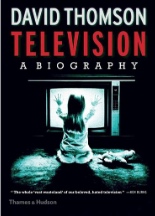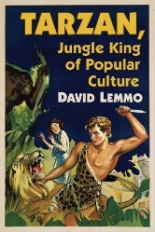 David Thomson is one of our finest living writers, period. He just so happens to work in the field of film criticism, yet his prose sings as marvelously as any acclaimed work of fiction. Each book he releases is an event for cineastes, including his latest … although it is about the movies’ archenemy. In the Thames & Hudson hardback Television: A Biography — heavy in size, heady in subject — Thomson relates the history of TV in the same manner he did cinema in 2012’s The Big Screen: purely on his terms. That means neither chronologically nor logically by anyone’s standards, yet the book feels that way once the whirlwind tour is done. The man can pivot on a dime, going from Gunsmoke to The Rockford Files to James Garner’s Polaroid ads with Mariette Hartley to Merv Griffin — and somehow, his dot-connecting leaps work. The cover image — the iconic one from 1982’s classic Poltergeist — is as good a joke as any, representing Thomson’s sometimes contentious relationship with the boob tube. And let’s be honest: His is ours.
David Thomson is one of our finest living writers, period. He just so happens to work in the field of film criticism, yet his prose sings as marvelously as any acclaimed work of fiction. Each book he releases is an event for cineastes, including his latest … although it is about the movies’ archenemy. In the Thames & Hudson hardback Television: A Biography — heavy in size, heady in subject — Thomson relates the history of TV in the same manner he did cinema in 2012’s The Big Screen: purely on his terms. That means neither chronologically nor logically by anyone’s standards, yet the book feels that way once the whirlwind tour is done. The man can pivot on a dime, going from Gunsmoke to The Rockford Files to James Garner’s Polaroid ads with Mariette Hartley to Merv Griffin — and somehow, his dot-connecting leaps work. The cover image — the iconic one from 1982’s classic Poltergeist — is as good a joke as any, representing Thomson’s sometimes contentious relationship with the boob tube. And let’s be honest: His is ours.
 While not quite a runaway smash, The Legend of Tarzan performed better than expected at last summer’s box office, proving there’s lots of life left in the lord of the apes. For the life already lived, David Lemmo recounts the pulp hero’s first century of existence in Tarzan, Jungle King of Popular Culture. Published by McFarland & Company, the trade paperback has the daunting task of distilling 100-plus years of content into roughly a 200-page narrative, and for the most part, the man succeeds. With Edgar Rice Burroughs writing dozens of novels starring his creation, adapted for dozens more motion pictures, there is little space for Lemmo to dive too deeply into individual works. Plus, the preceding sentence doesn’t take into account Tarzan’s adventures into TV, radio, comics, toys and other merchandising vines, all of which get covered here — just at a monkey’s-eye view. For example, the aforementioned Legend film merits one paragraph, but that’s more than is earned by Hollywood’s heretofore most recent live-action Tarzan film, 1998’s flop Tarzan and the Lost City (a vehicle for a loinclothed Casper Van Dien). Lemmo’s writing leans heavily on names and dates, so passages tend to grow arid. For those seeking a reference work on just the movies, reach for Scott Tracy Griffin’s recent Tarzan on Film; for a broad overview on the character’s wide-ranging market penetration and influence, Lemmo’s book serves as that introduction.
While not quite a runaway smash, The Legend of Tarzan performed better than expected at last summer’s box office, proving there’s lots of life left in the lord of the apes. For the life already lived, David Lemmo recounts the pulp hero’s first century of existence in Tarzan, Jungle King of Popular Culture. Published by McFarland & Company, the trade paperback has the daunting task of distilling 100-plus years of content into roughly a 200-page narrative, and for the most part, the man succeeds. With Edgar Rice Burroughs writing dozens of novels starring his creation, adapted for dozens more motion pictures, there is little space for Lemmo to dive too deeply into individual works. Plus, the preceding sentence doesn’t take into account Tarzan’s adventures into TV, radio, comics, toys and other merchandising vines, all of which get covered here — just at a monkey’s-eye view. For example, the aforementioned Legend film merits one paragraph, but that’s more than is earned by Hollywood’s heretofore most recent live-action Tarzan film, 1998’s flop Tarzan and the Lost City (a vehicle for a loinclothed Casper Van Dien). Lemmo’s writing leans heavily on names and dates, so passages tend to grow arid. For those seeking a reference work on just the movies, reach for Scott Tracy Griffin’s recent Tarzan on Film; for a broad overview on the character’s wide-ranging market penetration and influence, Lemmo’s book serves as that introduction.
 As you may have noticed with his previous book on Jamie Lee Curtis in 2010, when David Grove gets interested in a celebrity as a subject, he goes all in. Now, he’s gone all in on the troubled star of Damnation Alley, White Line Fever and TV’s Airwolf in Jan-Michael Vincent: Edge of Greatness. One of the best things about the BearManor Media release is that it exists at all; although once a matinee idol, Vincent is remembered more today (when he’s remembered at all) for substance abuse struggles and other tabloid fodder. I’ll be the first to admit I thought the actor already had died. Perhaps Grove’s book can help — not to rewrite Vincent’s history or legacy, but just to make certain that someone acknowledged his talent and, furthermore, mourned its loss. If you’re not already a fan, Edge of Greatness won’t change your mind; I suspect it won’t even be read by JM-V virgins. Working without input from or access to his subject, Grove guides us through each step of Vincent’s career at a quick clip, from its sharp ascent to an extended train wreck of a fall. Any fear on your part that Grove will indulge in hagiography is unwarranted, as the rather odd and sobering (pun not intended) final chapter makes clear. —Rod Lott
As you may have noticed with his previous book on Jamie Lee Curtis in 2010, when David Grove gets interested in a celebrity as a subject, he goes all in. Now, he’s gone all in on the troubled star of Damnation Alley, White Line Fever and TV’s Airwolf in Jan-Michael Vincent: Edge of Greatness. One of the best things about the BearManor Media release is that it exists at all; although once a matinee idol, Vincent is remembered more today (when he’s remembered at all) for substance abuse struggles and other tabloid fodder. I’ll be the first to admit I thought the actor already had died. Perhaps Grove’s book can help — not to rewrite Vincent’s history or legacy, but just to make certain that someone acknowledged his talent and, furthermore, mourned its loss. If you’re not already a fan, Edge of Greatness won’t change your mind; I suspect it won’t even be read by JM-V virgins. Working without input from or access to his subject, Grove guides us through each step of Vincent’s career at a quick clip, from its sharp ascent to an extended train wreck of a fall. Any fear on your part that Grove will indulge in hagiography is unwarranted, as the rather odd and sobering (pun not intended) final chapter makes clear. —Rod Lott
